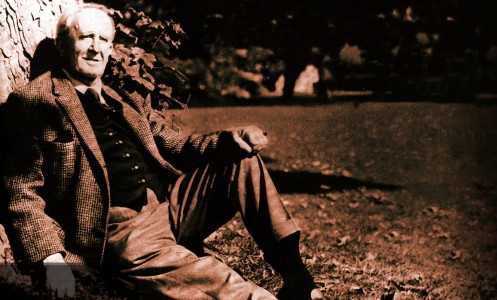Key Myths and Mythic Development of The Silmarillion --Beginnings and First Age
Mythic Development
We should not forget that The Silmarillion, edited and reconstructed by Christopher Tolkien is not the same thing as the multiple portions and versions, mostly incomplete, of J.R.R. Tolkien's mythology that his son has collected and analyzed in The History of Middle Earth. The history of the Silmarillion is an especially complicated one, so to try and divide it into several periods is inevitably reductionistic, yet I personally find it helpful to keep a broad picture in mind. The development of the Silmarillion as a larger mythology can be broken down into the following overall periods:

- Pre- Book of Lost Tales: Early poems and paintings that show the very beginnings of Tolkien's mythology, such as The Shores of Faëry and "The Voyage of Éarendel the Evening Star."
- Book of Lost Tales (ca. 1916-1920): The first versions of The Silmarillion myths, different enough that they can be considered a separate work entirely.
- The Lays of Beleriand (ca. 1920-1931): Two early long poems, both incomplete. The Lay of Leithian is a development of the Beren-Lúthien myth. The Lay of the Children of Húrin is a version of the Hú́rin and Túrin stories.
- Earlier Silmarillion (ca. 1926-1937): The Silmarillion as a system during this period, prior to the writing of The Lord of the Rings, takes shape through numerous revisions and reworkings of the various portions of the mythology.
- Later Silmarillion (ca. 1948-1960): After the completion of The Lord of the Rings, Tolkien returns to the mythology with more revisions and additions. The text of The Silmarillion edited by C. Tolkien mostly draws from this material with the exception of chapters 22-24, which had to be created based on suppositions mostly from Tolkien's earlier plans and versions.
- Late Essays, Tales, and Appendices (ca. 1950-1970's): Additional material Tolkien wrote to fill out or explain various elements in The Silmarillion mythology.
Again, I should stress that the real picture is more complicated than this, and the serious student of Middle-earth will wish to go to the sources in The History of Middle-Earth.
Main Myths
Critics of Tolkien, especially those who work in medieval literature, often describe the experience of encountering The History of Middle-Earth as a lot like reading the large and varied legendarium of a mythic cycle, such as the Arthurian legends. There are numerous versions, often incomplete or contradictory, but deeply interesting and fascinatingly suggestive. The edited Silmarillion is more like a compendium of these. There are key myths that continue through the history of the Silmarillion, and it is helpful to see how these form the core of the edited volume. Think of them as a series of nexus points around which clusters of story collect. The main points of convergence are:
- The Creation Myth (principally in Ainulindalë and Valaquenta) with, as the Music of the Ainur unfolds, the Coming of the Elves and Men as extensions of this.
- The Summons to Valinor and the Darkening of Valinor
- Fëanor and the Silmarils, including the Oath and Three Kinslayings
- The War with Morgoth, especially the five main battles of Bereliand
- Beren-Lúthien
- The Children of Húrin
- The Kingdoms of Doriath, Nargothrond, and Gondolin
- The Voyage of Eärendil
There is, obviously, within this much overlap. For example, the fall of Doriath results from Beren and Lúthien recovering a Silmaril and bringing about the consequences of the Oath, the curse on Túrin brings an end to Nargothrond, etc.
A Few Key Themes
- Creation and Fall
- Light and Darkness
- Fate, Providence , and Free Will
- Pride, Glory, Heroism, and Honor
- The Nature of Love and Desire
- Death and Deliverance
- A Longing for the Unrecovered Past
- The Nature of Tragedy
- Subcreation
- Autonomy and Kinship
